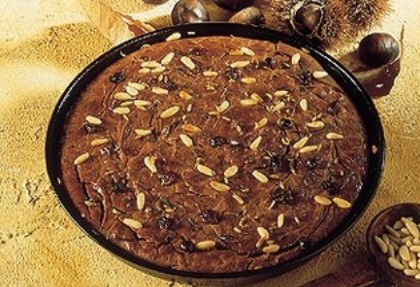
Keith Haring celebrations, 20 years from the date of his painting of the mural in Pisa, the Comune organises a day of activities in front of this famous work.
Event on 16 february 2010
Official website: www.haring.com
Experience a truly enchanting holiday in one of my Tuscan Villas

Keith Haring celebrations, 20 years from the date of his painting of the mural in Pisa, the Comune organises a day of activities in front of this famous work.
Event on 16 february 2010
Official website: www.haring.com

Danza in Fiera 2010
Demonstrations, competions, costumes and accessories market for all disciplines of dance from classic to Latin American to hip hop.
The biggest dance exhibition in Europe.
Entrance euro 15,00
Place: Fortezza da Basso – Florence
From 25 till 28 february 2010
Official website: www.danzainfiera.it

Arezzo Wine 2010, show and market.
Tasting food stalls, forums, Vini d’Epoca sale and swap of vintage wines.
Entrance euro 10,00 with free Artezzo Wine Glass.
From 27 february till 1 march.
Place: Centro Affari e Congressi città di Arezzo (10.000 mq)
Official web site: www.arezzowine.it

In Lucca Centre of Contemporany Art there is an exhibition that i would be a real shame to miss. The central theme is a bull.
Several versions of it in different poses: charging, still, defeated, playful and enraged. Never passive. Always challenging. You may have alreay noticed a large coloured bull lying down in Piazza Scalpellini, nera Piazza Anfiteatro, off via Fillungo. On its rear is written: “It isn’t true but i bielieve it”
The bull which took nine and half months to make appeared out of nowwhere on day, and is part of the exhibition.
Christian Balzano comes from Livorno where he was born in 1969. he’s extremely versatile: he works in plaster, animal, skin, canvas, wood, acrylic, resin, copper, acid, plastic and gold leaf. He uses words, video and photography; he paints, model scratches and engraves. He also incorporates music smells into this fascinating show. It is part installation, part animation, part sculpture, largely paintings, but most excitingly it asks the audience to partecipate. And this audience can include everyone from adult to child.
As soon as we walk into the museum we get a sense of what we are to see in the rest of the show. On one wall there are over 50 small iconic pieces in brilliant reds, blacks and golds some framed of Buddhas, cherubs, Madonna, hearts, candelabras, bulls, the star of David, the hal moon and chinese dragons.
A collection of references which reappear throughout the exhibition. Over the reception area is there a sequence of witty photographs of people wearing bull’s heads. If you follow the exhibition upstairs you come to a large room with paintings.
After you can find two rooms, Black or Red, you must choose….you have to discover this for yourselves..
There is anothe room off the main one, with a series of exquisite wooden plates on the wall, with figures drawn in gold leaf. Upstairs there is anothe area, essentially divided by the colours the artist has chosen to frame his works: white, red, black and gold.
Going back to the bull lying in the little piazza near Via Fillungo. Is the bull defeated? Beckoning? Toying with us? Has it fallen^ Decide for yourself. Touch it. Climb over it. That’s what the artist wants!
The exhibition runt until 21 of february.
Lu.C.C.A.
Via della Fratta 36 – 55100 LUCCA – Tel. +39 0583 571712
www.luccamuseum.com

What could be more Lucchese than Castagnaccio (chestnut tart)?
It is said to have been first created by a Pilade di Lucca. It’s a typical tuscan dessert. The key ingredient is chestnut flour “farina di castagne” or “farina dolce” traditionally made in the winter months. It is a most delicate flour with a sweet, rich flavour, made from dried, milled chestnuts.
It can now be found in specialists flour suppliers outside Italy, although readers living in Lucca willa have no diffuculty to finding excellent local produce from the Garfagnana.
Ingredients: ( serves 8 )
. 400 g chestnut flour (the best you can find, from Garfagnana)
. 6 tablespoonfuls extra virgin olive oil
. Approx 600/800 ml. water
. 1 cup of peeled pine seeds (pinoli)
. 3 tablespoonfuls of sugar
. 1 orange
. pinch of salt
. fresh rosemary leaves
. ricotta (cottage cheese of ewe’s milk)
Method:
Whisk the chestnut flour with the salt, sugar, grated orange rind and 3 tablespoonfuls of olive oil.
Warm up the water to more than lukewarm and add it little by little to the mixture to obtain a liquid creamy consistency. pour this cream into an oiled 30/32 cm diameter baking tin.
Sprinkle with the rosemary leaves and pine seeds and spread the ramaining olive oil over it.
Place in an oven heated to 220° C and cook 30/40 minutes.
The Castagnaccio should be crispy in the top and creamy inside. Serve hot with a generous portion of fresh ricotta.
This is a very ancient local recipe, not difficult to prepare but as is always the case with simple recipes the ingriedients must be top quality.